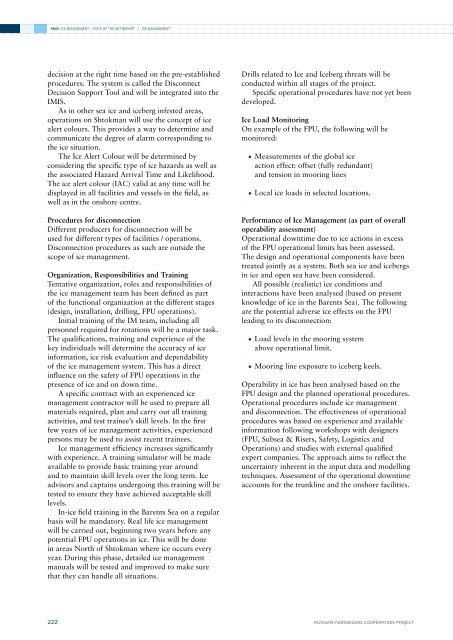phase 4 report - DNV
phase 4 report - DNV
phase 4 report - DNV
Create successful ePaper yourself
Turn your PDF publications into a flip-book with our unique Google optimized e-Paper software.
RN06: ICE MANAGEMENT – STATE OF THE ART REPORT // Ice Managementdecision at the right time based on the pre-establishedprocedures. The system is called the DisconnectDecision Support Tool and will be integrated into theIMIS.As in other sea ice and iceberg infested areas,operations on Shtokman will use the concept of icealert colours. This provides a way to determine andcommunicate the degree of alarm corresponding tothe ice situation.The Ice Alert Colour will be determined byconsidering the specific type of ice hazards as well asthe associated Hazard Arrival Time and Likelihood.The ice alert colour (IAC) valid at any time will bedisplayed in all facilities and vessels in the field, aswell as in the onshore centre.Procedures for disconnectionDifferent producers for disconnection will beused for different types of facilities / operations.Disconnection procedures as such are outside thescope of ice management.Organization, Responsibilities and TrainingTentative organization, roles and responsibilities ofthe ice management team has been defined as partof the functional organization at the different stages(design, installation, drilling, FPU operations).Initial training of the IM team, including allpersonnel required for rotations will be a major task.The qualifications, training and experience of thekey individuals will determine the accuracy of iceinformation, ice risk evaluation and dependabilityof the ice management system. This has a directinfluence on the safety of FPU operations in thepresence of ice and on down time.A specific contract with an experienced icemanagement contractor will be used to prepare allmaterials required, plan and carry out all trainingactivities, and test trainee’s skill levels. In the firstfew years of ice management activities, experiencedpersons may be used to assist recent trainees.Ice management efficiency increases significantlywith experience. A training simulator will be madeavailable to provide basic training year aroundand to maintain skill levels over the long term. Iceadvisors and captains undergoing this training will betested to ensure they have achieved acceptable skilllevels.In-ice field training in the Barents Sea on a regularbasis will be mandatory. Real life ice managementwill be carried out, beginning two years before anypotential FPU operations in ice. This will be donein areas North of Shtokman where ice occurs everyyear. During this <strong>phase</strong>, detailed ice managementmanuals will be tested and improved to make surethat they can handle all situations.Drills related to Ice and Iceberg threats will beconducted within all stages of the project.Specific operational procedures have not yet beendeveloped.Ice Load MonitoringOn example of the FPU, the following will bemonitored:• Measurements of the global iceaction effect: offset (fully redundant)and tension in mooring lines• Local ice loads in selected locations.Performance of Ice Management (as part of overalloperability assessment)Operational downtime due to ice actions in excessof the FPU operational limits has been assessed.The design and operational components have beentreated jointly as a system. Both sea ice and icebergsin ice and open sea have been considered.All possible (realistic) ice conditions andinteractions have been analysed (based on presentknowledge of ice in the Barents Sea). The followingare the potential adverse ice effects on the FPUleading to its disconnection:• Load levels in the mooring systemabove operational limit.• Mooring line exposure to iceberg keels.Operability in ice has been analysed based on theFPU design and the planned operational procedures.Operational procedures include ice managementand disconnection. The effectiveness of operationalprocedures was based on experience and availableinformation following workshops with designers(FPU, Subsea & Risers, Safety, Logistics andOperations) and studies with external qualifiedexpert companies. The approach aims to reflect theuncertainty inherent in the input data and modellingtechniques. Assessment of the operational downtimeaccounts for the trunkline and the onshore facilities.222RUSSIAN–NORWEGIAN COOPERATION PROJECT






![Risk Based Pipeline Integrity Management [Compatibility Mode] - DNV](https://img.yumpu.com/50424229/1/190x146/risk-based-pipeline-integrity-management-compatibility-mode-dnv.jpg?quality=85)









